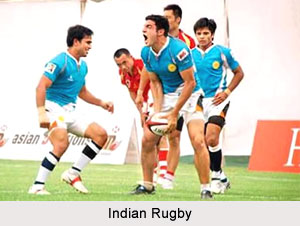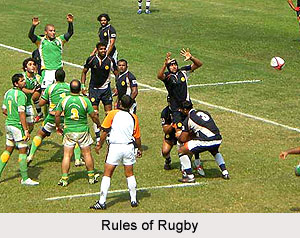 Game of Rugby is played with hands and feet, and an oval ball, between two teams of 15 players each, plus 7 substitutes. The game consists on catching or picking up the ball and running with it, passing, throwing or knocking the ball to another player for scoring points, as well as kicking the ball. To take the ball from the other team, it`s also possible to push or shoulder an opponent holding the ball. The specificity of the game is that passes to another team member are always in the back. The duration of the game is 2 h 40 min with a half-time of 10min
Game of Rugby is played with hands and feet, and an oval ball, between two teams of 15 players each, plus 7 substitutes. The game consists on catching or picking up the ball and running with it, passing, throwing or knocking the ball to another player for scoring points, as well as kicking the ball. To take the ball from the other team, it`s also possible to push or shoulder an opponent holding the ball. The specificity of the game is that passes to another team member are always in the back. The duration of the game is 2 h 40 min with a half-time of 10min
Scoring of Rugby
 The aim of rugby union is to score more points than the opposition Teams score in several ways:
The aim of rugby union is to score more points than the opposition Teams score in several ways:
(a) Touching the ground over the opponents` goal line with the ball using the hand, hands, arm or arms. The opponents` goal line includes the base of the posts, which is considered to be part of the goal line- doing either of this result in a try, worth 5 points. The try got its name because originally the touching down of the ball only gave you a "try" at scoring by successfully kicking for goal, which were the only points scored if the kick was good.
(b) After scoring a try, the scoring team attempts a conversion: a player takes a kick at goal in line with where the touch-down occurred. Scoring the goal earns 2 points.
(c) Kicking the ball above the crossbar and between the uprights of a large `H`-shaped set of posts. Goal kicking is a major part of the game, with games being won and lost at these situations. Therefore the points will be scored as such:
* Try: 5 points
* Conversion: 2 points
(d) This may be attempted either by a place-kick or a drop kick (commonly called a drop-goal). The ball is kicked from the halfway line into the opponent`s half and must travel at least 10 metres. The ball is place-kicked for the start of each half and drop kicked to restart after the opposing side has scored. The kicker`s team-mates must be behind the halfway line at the moment the ball is kicked. The opposing players must be on or behind their 10 metres line.
Scrummage
This results from a foul. It must be composed of eight players from each team (3 front row players, 2 second row and 3 from the back row) who must remain linked together for as long as the scrum continues.
Generally, each front row player puts his head to the left of that of his opponent, and his shoulders must always be higher than his waist. The ball is then introduced, on the ground, into the tunnel formed by the front row players. The hooker rucks the ball with his foot towards the rear of his scrum. The scrum-half collects the ball as soon as it leaves the scrum to restart open play.
The Maul
As with the ruck, this is a situation that occurs in open play and is not the result of an infringement. The maul is formed in the same way as the ruck but the players surround the player with the ball. At least 3 players are needed for a maul (the player in possession of the ball plus (+) one team-mate and one opponent). The maul ends when the ball goes to ground or the player with the ball gets free of the maul. If the ball is unplayable or if the maul ceases to move forward, the referee will intervene.
The Line Out
There is a line-out when the ball goes into touch. If the ball goes directly into touch, the throw in is awarded to the opposing team at the point where the ball was played.
If the ball goes directly into touch, the throw-in is awarded to the opposing team at the point where the ball was played, unless the kicker is within his 22 metre line. In this case the throw-in is taken at the point where the ball goes into touch.
If the ball touches the ground inside the playing area before going into touch, the throw-in is awarded to the opposing team at the point where the ball went out, wherever the player was when the ball was played.
From a Penalty Kick:
The team taking the penalty kick and who kick the ball directly into touch takes the throw-in at the point where the ball goes out. To form a line-out, each team must form a line composed of at least two players. The two lines (one per team) must be parallel to the line of the throw-in. Players not involved in the line-out must be at least 10 metres from the line of the throw-in.
The Tackling
Tackling is a defensive action. It consists of intercepting the player in possession of the ball and holding on to him or making him fall over (with one`s arms) so that he releases the ball. It is against the rules to throw oneself on top of a tackled player who is in possession of or near the ball.
Kick in Open Play
Kicking enables a team to find touch, to gain ground or, of course, to score points. It is an essential part of the play. It consists of kicking the ball in the desired direction, though there are several different types of kick:
The kick ahead may be collected by the kicker to make ground, or any either player behind him at the time the ball was kicked.
The "up and under" (a kick launched high enough to enable the kicker`s team-mates to position themselves to jump to collect the ball before they touch the ground).
The centralized cross-kick (a kind of up and under allowing the ball to be sent back towards the middle of the pitch)
The drop goal which is kicked on the half volley between the goalposts and over the cross bar, if successful, this kick scores 3 points
The Try
A player scores a try when he touches the ball down in the opponent`s in-goal.
Calling the Mark
A player may call for the mark when he catches the ball on the volley or on behind his 22 metre line. The ball must have come directly from an opposing player`s kick. The player who catches the ball must call "Mark".
The Off Side
A player is offside:
a. When he is in front of a team-mate who has the ball or has just played it;
b. During a ruck or scrummage if he remains or advances in front of the offside line. Only the number 8 is allowed to detach himself from the ruck or scrummage and collect the loose ball; and
c. If before a line-out is completed, a non- participating player advances or remains in front of the on line.
Unsportsmanlike Conduct
Unsportsmanlike conduct occurs where an action breaches the rules or spirit of the game. This includes obstruction, unfair action, dangerous play, unsporting behaviour or repeated foul play. These infringements may result in players being sent off, cautioned, or the awarding of penalty tries or penalty kicks.
Yellow and Red Cards
In the Five Nations Tournament and in all international matches, the yellow card represents a caution. Now in the six nations Tournament, if the referee judges a player to be guilty of an aggressive play or accidental unsportsmanlike conduct, he must temporarily exclude the guilty player without further warning. To do this, he summons the player at fault, and shows him a yellow card. The player is sent behind the opposing team`s dead ball line. The minimum duration of the exclusion is 10 minutes. The red card means a player is definitively sent off. It is handed out in cases of violent conduct, dangerous play and dissent or threatening behaviour towards the referee.
The Penalty
This is a punishment for a team that has committed a foul. The penalty kick may be taken in the same way as a conversion, and in this manner is worth 3 points. It may also be taken rapidly in order to keep play moving. Finally, it can be kicked into touch, and in this case, the kicking team will take the throw-in. The team awarded the penalty kick can ask the referee to replace it with a scrimmage